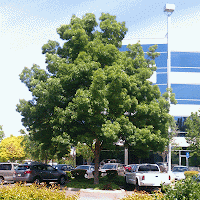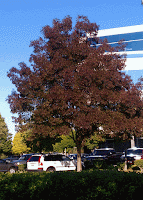Pyrus calleryana ‘Aristocrat’
(Aristocrat Pear) is in the Rosaceae family, and is a selection of the species.
The tree is deciduous, and key diagnostics include leaves that are alternate, simple, 1 ½ - 3”, dark glossy green, ovate to broadly obovate, glabrous, with lightly crenate edges, short acuminate ends, rounded cuneate at the base, with lighter undersides, and fall color (yellow to pinkish orange to scarlet red). Flowers are showy, 3-4” wide corymb clusters in spring before leaves emerge (in Dublin, the brown leaves persist all winter, then flowers emerge in spring to cover the tree, followed by leaves; sometimes on the tree all at once). Fruits are inedible, tan, ½” pomes (pears). Bark is smooth, whitish gray-brown, becoming shallowly fissured with scaly ridges.
 |
| Pyrus calleryana ‘Aristocrat’ - leaf shape and form. |
The tree is deciduous, and key diagnostics include leaves that are alternate, simple, 1 ½ - 3”, dark glossy green, ovate to broadly obovate, glabrous, with lightly crenate edges, short acuminate ends, rounded cuneate at the base, with lighter undersides, and fall color (yellow to pinkish orange to scarlet red). Flowers are showy, 3-4” wide corymb clusters in spring before leaves emerge (in Dublin, the brown leaves persist all winter, then flowers emerge in spring to cover the tree, followed by leaves; sometimes on the tree all at once). Fruits are inedible, tan, ½” pomes (pears). Bark is smooth, whitish gray-brown, becoming shallowly fissured with scaly ridges.






























